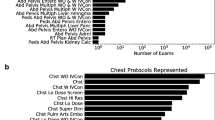Abstract
Background
Default pediatric protocols on many digital radiography systems are configured based on patient age. However, age does not adequately characterize patient size, which is the principal determinant of proper imaging technique. Use of default pediatric protocols by inexperienced technologists can result in patient overexposure, inadequate image quality, or repeated examinations.
Objective
To ensure diagnostic image quality at a well-managed patient radiation exposure by transitioning to thickness-based protocols for pediatric portable abdomen radiography.
Materials and methods
We aggregated patient thickness data, milliamperes (mAs), kilovoltage peak (kVp), exposure index (EI), source-to-detector distance, and grid use for all portable abdomen radiographs performed in our pediatric hospital in a database with a combination of automated and manual data collection techniques. We then analyzed the database and used it as the basis to construct thickness-based protocols with consistent image quality across varying patient thicknesses, as determined by the EI.
Results
Retrospective analysis of pediatric portable exams performed at our adult-focused hospitals demonstrated substantial variability in EI relative to our pediatric hospital. Data collection at our pediatric hospital over 4 months accumulated roughly 800 portable abdomen exams, which we used to develop a thickness-based technique chart.
Conclusion
Through automated retrieval of data in our systems’ digital radiography exposure logs and recording of patient abdomen thickness, we successfully developed thickness-based techniques for portable abdomen radiography.




Similar content being viewed by others
References
National Research Council (2006) Health risks from exposure to low levels of ionizing radiation (Committee to Assess Health Risks from Exposure to Low Levels of Ionizing Radiation, BEIR VII – Phase 2). National Academies Press, Washington, DC
United Nations Scientific Committee on the Effects of Atomic Radiation (2014) UNSCEAR 2013 report vol. II: sources, effects and risks of ionizing radiation. Scientific annex B: effects of radiation exposure of children. United Nations, New York
Don S, MacDougall R, Strauss K et al (2013) Image Gently campaign Back to Basics initiative: ten steps to help manage radiation dose in pediatric digital radiography. AJR Am J Roentgenol 200:W431–W436
Willis CE (2004) Strategies for dose reduction in ordinary radiographic examinations using CR and DR. Pediatr Radiol 34:S196–S200
Uffmann M, Schaefer-Prokop C (2009) Digital radiography: the balance between image quality and required radiation dose. Eur J Radiol 72:202–208
Kleinman PL, Strauss KJ, Zurakowski D et al (2010) Patient size measured on CT images as a function of age at a tertiary care children’s hospital. AJR Am J Roentgenol 194:1611–1619
Shepard SJ, Wang J et al (2009) An exposure indicator for digital radiography: AAPM task group 116 (executive summary). Med Phys 36:2898–2914
Seibert JA, Morin RL (2011) The standardized exposure index for digital radiography: an opportunity for optimization of radiation dose to the pediatric population. Pediatr Radiol 41:573–581
Moore QT, Don S, Goske MJ et al (2012) Image Gently: using exposure indicators to improve pediatric digital radiography. Radiol Technol 84:93–99
Shah C, Jones AK, Willis CE (2008) Consequences of modern anthropometric dimensions for radiographic techniques and patient radiation exposures. Med Phys 35:3616–3625
Zhang M, Liu K, Niu X et al (2013) A method to derive appropriate exposure parameters from target exposure index and patient thickness in pediatric digital radiography. Pediatr Radiol 43:568–574
Cohen MD, Cooper ML, Piersall K et al (2011) Quality assurance: using the exposure index and the deviation index to monitor radiation exposure for portable chest radiographs in neonates. Pediatr Radiol 41:592–601
Cohen MD, Markowitz R, Hill J et al (2012) Quality assurance: a comparison study of radiographic exposure for neonatal chest radiographs at 4 academic hospitals. Pediatr Radiol 42:668–673
Mothiram U, Brennen PC, Robinson J et al (2013) Retrospective evaluation of exposure index (EI) values from plain radiographs reveals important considerations for quality improvement. J Med Radiat Sci 60:115–122
Yasumatsu S, Tanaka N, Iwase K et al (2016) Effect of X-ray beam quality on determination of exposure index. Radiol Phys Technol 9:109–115
Acknowledgments
This work was performed with REDCap software, supported by the National Institutes of Health CTSA UL1 TR000430.
Author information
Authors and Affiliations
Corresponding author
Ethics declarations
Conflicts of interest
None
Rights and permissions
About this article
Cite this article
Sánchez, A.A., Reiser, I., Baxter, T. et al. Portable abdomen radiography: moving to thickness-based protocols. Pediatr Radiol 48, 210–215 (2018). https://doi.org/10.1007/s00247-017-4025-4
Received:
Revised:
Accepted:
Published:
Issue Date:
DOI: https://doi.org/10.1007/s00247-017-4025-4




